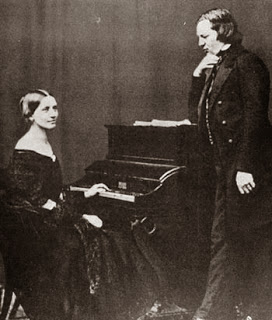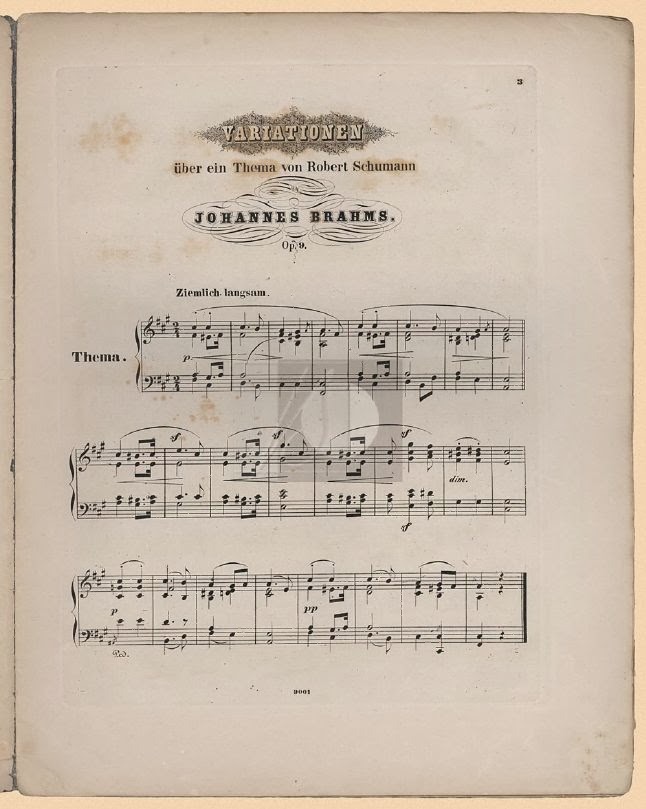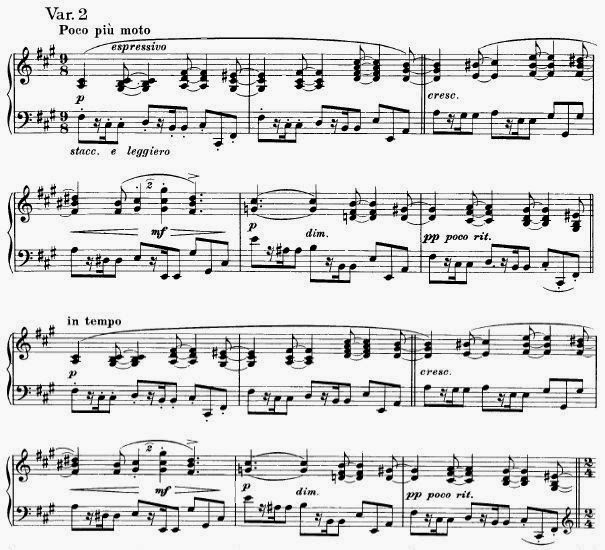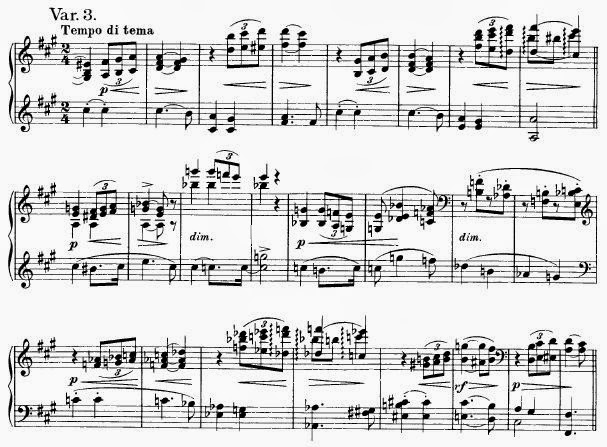 |
| Brahms at 20, the age he met the Schumanns and wrote Variations on a Theme by Schumann |
 |
| Clara and Robert Schumann, at the approximate age they met Brahms |
Bunte Blätter consisted of two groups, Drei Stücklein (Three Small Pieces) and five pieces entitled Albumblätter (Album-leaves). The first of the Albumblätter was a favourite of his wife, Clara. The poignant theme included a sequence of notes spelling out Clara's name (C-B-A-G#-A). Schumann had used it before, for example, in the C Minor Piano Quartet and the Fourth Symphony in D minor, so often that it has been called 'Clara's Theme'.
 |
| "Clara" theme from Schumann's Bunte Blätter, Op. 99 |
 |
| The "Clara" theme |
 |
| Clara Wieck, age 17 |
 |
| Clara, 1840, as a bride |
In May and June of 1853 Clara wrote a set of variations on the theme (her Op. 20), dedicating it to Robert and presenting the autograph to him as a gift on his forty-third birthday, the last birthday he would spend with his family. Her inscription read, "To my beloved husband on June 8, 1853; this renewed feeble attempt from his old Clara." She composed very little after this.
 |
| Robert Schumann, 1850 |
Schumann's growing mental disturbances climaxed on February 27, 1854 when he attempted suicide by throwing himself into the Rhine River. Fearing that he would harm his family, he insisted that he be sent away. On March 4 he was committed to an asylum in Endenich, near Bonn, not far from the family home in Düsseldorf. He died in the asylum two years later on July 29, 1856.
Although Brahms, aged twenty, had met the Schumanns only a few months earlier, on Sept. 30, 1853, Robert, Clara, and Johannes had quickly become devoted to each other. Upon receiving the news of Schumann's illness, Brahms returned to the Schumann household in Düsseldorf to comfort the distraught Clara, who was pregnant with her seventh child, to help with the children, to take charge of the family finances, and generally to fill the shoes of Robert. He remained in Düsseldorf for two years, supporting himself by giving a few piano lessons but mostly by borrowing money from friends. After Robert's death, Clara wrote the following about Brahms to her children:
Like a true friend, he came to share all my grief; he strengthened the heart that threatened to break, he uplifted my spirit; brightened my soul in any way he could. He was, in short, my friend in the fullest sense of the word.
In May Clara played her variations on Robert's theme for Brahms. Brahms immediately set about writing his own set of variations on the theme, showing each variation to Clara as soon as it was completed. Of the sixteen variations in the final set, fourteen were written in May and June of that year (1854). On June 15 he sent her a completed manuscript headed 'Short Variations on a Theme by Him, Dedicated to Her'. Clara later wrote,
“He tried to bring solace to my heart. He composed variations on the beautiful, intimate theme which made such a deep impression upon me a year ago when I composed variations for my beloved Robert, and touched me deeply by his tender thoughtfulness.”
In July Brahms sent his variations to his friend, Josef Joachim, who replied positively: "I recognize the richness of feeling and spirit . . . each variation is a small temple to the spirit." In August Brahms wrote Joachim telling him that he had added two more variations (nos. 10 and 11), adding that in one of them "Clara speaks!" In September Clara made arrangements for Breitkopf & Härtel to publish her variations. On September 24 Brahms offered his set to Breitkopf & Härtel and, when it was accepted for publication, wrote back, with the proofs of Clara's variations, requesting that his be published together with Clara's, which was done in November. Brahms now subtitled his work ‘Little variations on a theme of His dedicated to Her’. Clara sent a copy of each set to Schumann in the asylum. To Brahms she gave a copy of hers inscribed 'For the creator of the finest variations, these little ones' (see below). When he asked for her manuscript, she inscribed it 'For the esteemed Johannes Brahms, on friendly request'.
Robert drafted the following letter to Brahms:
My Dearest Friend,
What very great pleasure you have given me with your Variations! My Clara has already written to tell me how delighted she was with them. That you have studied counterpoint deeply is apparent in all the Variations. How tender, how original in its masterly expression, how ingenious every one of them! How I should like to hear you or Clara play them! And then, the wonderful variety! The third, the fourth, the fifth, the sixth with its retrogression in the second part. The following Andante, how tender: the eighth with its beautiful second part. Then the ninth, how beautiful in form; the tenth, how full of art, how tender; how individual and delicate the eleventh, and how ingeniously the twelfth joins it! Then the thirteenth, with its sweet metaphysical tones, and next the Andante, with its witty and artistic canon in seconds, and the fifteenth in C flat major, the sixteenth beautifully and blessedly ending in F sharp major. How sincerely my Clara and I have to thank you for your dedication! I thank you also most heartily for giving so much of your previous time to my Clara. Write to me; I should be delighted.
Your admiring friend,
Robert
However, he did not send it.[1] Instead he sent the following on November 27, 1854 :
In Brahms’ manuscript, variations are signed with either a "B" or a "Kr," standing for Brahms or Johannes Kreisler, the fictional character created by the Romantic writer, E. T. A. Hofmann. Brahms is echoing the practice of Schumann, who created two alter egos for himself, "Florestan," representing the passionate, outgoing side of his nature and "Eusebius," the withdrawn, reflective side. The "B" variations are cooler, scholarly, reflective, while the "Kr" variations are more passionate, impulsive, lyrical.
According to Charles Rosen, in each variation it is possible to find an echo of some work of Schumann, as if Brahms is paying homage to Schumann's life work rather than just writing variations on one of his themes. The musical quotations, the counterpoint, the sudden juxtapositions, the modulation away from the key of the theme — something Brahms avoided in his later variation sets — all recall characteristic features of Schumann.
Julius Otto Grimm, a close friend of Brahms, dubbed the Schumann Variations "Trost-Einsamkeit" (Consoling Loneliness).
Julian Littlewood in his study, The Variations of Johannes Brahms, describes the work as "one of the most unguarded, personal statements he [Brahms] ever made."[2]
Note: The score for Brahms's Variations on a Theme by Schumann, Op. 9 is available free from the International Music Score Library Project at
http://imslp.org/wiki/Variations_on_a_Theme_by_Robert_Schumann,_Op.9_(Brahms,_Johannes)
1. Karl Geiringer, Brahms: His Life and Work, 1984, p. 211-12.
2. Julian Littlewood, The Variations of Johannes Brahms, Plumbago Books, 2004, p. 253.
 |
| First Edition, Brahms, Variations on a Theme of Schumann, Op. 9 |
Brahms's copy of Clara Schumann's Variations on a Theme of Schumann, Op. 20.
Inscribed by Clara, "Dem schöpfer der herrlichsten Variationen Johannes Brahms,
diese kleinen" (To Johannes Brahms, the creator of the finest variations, these little ones)


















